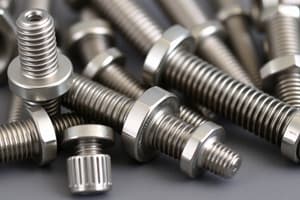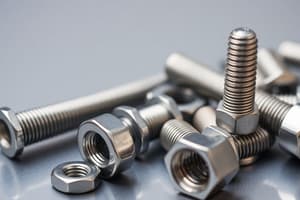Podcast
Questions and Answers
Aircraft bolts are almost always manufactured with a
Aircraft bolts are almost always manufactured with a
- class 1 fit for the threads.
- class 2 fit for the threads.
- class 3 fit for the threads. (correct)
In an aircraft, where is an AN clevis bolt typically employed?
In an aircraft, where is an AN clevis bolt typically employed?
- Only for shear load applications. (correct)
- Where external tension loads are applied.
- For tension and shear load conditions.
What is the method for properly fastening a clevis bolt with a fork end cable terminal?
What is the method for properly fastening a clevis bolt with a fork end cable terminal?
- With a shear nut tightened to a snug fit, but with no strain imposed on the fork and safetied with a cotter pin (correct)
- With a shear nut and cotter pin or a thin self locking nut tightened enough to prevent rotation of the bolt in the fork.
- With a castle nut tightened until slight binding occurs between the fork and the fitting to which it is being attached.
What is the classification of a bolt featuring an X within a triangle on its head?
What is the classification of a bolt featuring an X within a triangle on its head?
What classification is given to a bolt with a solitary raised dash on its head?
What classification is given to a bolt with a solitary raised dash on its head?
What is the significance of aircraft bolts featuring a cross or asterisk marked on the bolthead?
What is the significance of aircraft bolts featuring a cross or asterisk marked on the bolthead?
If a bolt has a "7" in its specification, what is the diameter in inches?
If a bolt has a "7" in its specification, what is the diameter in inches?
What is the length in inches of a bolt specified as "6"?
What is the length in inches of a bolt specified as "6"?
Self-locking nuts are permissible for aircraft application as long as...
Self-locking nuts are permissible for aircraft application as long as...
What is the method employed to achieve the locking feature of a fiber-type locknut?
What is the method employed to achieve the locking feature of a fiber-type locknut?
For which type of aluminum parts are the 1100 rivets, described in the provided information, primarily intended?
For which type of aluminum parts are the 1100 rivets, described in the provided information, primarily intended?
What are the 2017-T and 2024-T rivets commonly known as
What are the 2017-T and 2024-T rivets commonly known as
What can Monel rivets be used for?
What can Monel rivets be used for?
What primary factor influences the selection of dwell time during the conduction of a dye or fluorescent penetrant inspection among the options provided?
What primary factor influences the selection of dwell time during the conduction of a dye or fluorescent penetrant inspection among the options provided?
What is the recommended cleaning procedure for a part that is being prepared for dye penetrant inspection?
What is the recommended cleaning procedure for a part that is being prepared for dye penetrant inspection?
Liquid penetrant inspection methods may be used on which of the following?
1.Smooth primer-sealed wood.
2.Nonporous plastics.
3.Porous plastics.
4.Ferrous metals.
5.Nonferrous metals.
Liquid penetrant inspection methods may be used on which of the following? 1.Smooth primer-sealed wood. 2.Nonporous plastics. 3.Porous plastics. 4.Ferrous metals. 5.Nonferrous metals.
When conducting a dye penetrant inspection, the developer...
When conducting a dye penetrant inspection, the developer...
What is typically necessary to identify a tiny crack when employing dye penetrant inspection?
What is typically necessary to identify a tiny crack when employing dye penetrant inspection?
When dye penetrant inspection indications lack sharpness and clarity, the likely reason is that the component is...
When dye penetrant inspection indications lack sharpness and clarity, the likely reason is that the component is...
Which nondestructive testing technique necessitates minimal or no preparation of the component, is employed for identifying surface or closely situated defects in the majority of metals, and can also differentiate between metals or alloys and their heat treatment states?
Which nondestructive testing technique necessitates minimal or no preparation of the component, is employed for identifying surface or closely situated defects in the majority of metals, and can also differentiate between metals or alloys and their heat treatment states?
Among these nondestructive testing techniques, which one is appropriate for examining surface and subsurface defects in a wide range of materials like metals, plastics, and ceramics?
Among these nondestructive testing techniques, which one is appropriate for examining surface and subsurface defects in a wide range of materials like metals, plastics, and ceramics?
Flashcards are hidden until you start studying



